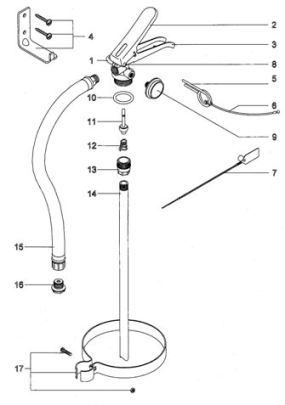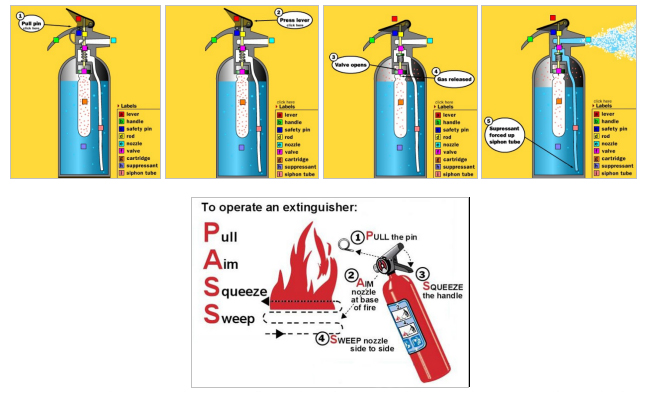|
| |
| Fire
Extinguishers: |
| A fire extinguisher is
an active fire protection device used to extinguish
or control small fires, often in emergency
situations. It is not intended for use on an
out-of-control fire, such as one which has reached
the ceiling, endangers the user (i.e., no escape
route, smoke, explosion hazard, etc.), or otherwise
requires the expertise of a fire department.
Typically, a fire extinguisher consists of a
hand-held cylindrical pressure vessel containing an
agent which can be discharged to extinguish a fire. |
| |
| There are two
main types of fire extinguishers: Stored pressure &
Cartridge-Operated: |
| |
| •
Stored Pressure: In stored pressure units,
the expellant is stored in the same chamber as the
firefighting agent itself. Depending on the agent
used. With dry chemical extinguishers, nitrogen is
typically used; water and foam extinguishers
typically use air. Stored pressure fire
extinguishers are the most common type. |
| |
•
Cartridge Operated: Cartridge-operated
extinguishers contain the expellant gas in a
separate cartridge that is punctured prior to
discharge, exposing the propellant to the
extinguishing agent. This type is not as common,
used primarily in areas such as industrial
facilities, where they receive higher-than-average
use. They have the advantage of simple and prompt
recharge, allowing an operator to discharge the
extinguisher, recharge it, and return to the fire in
a reasonable amount of time.
|
| |
|
Components of the System |
 |
|
1 |
Valve assembly |
|
2 |
Operating lever |
|
3 |
Support handle |
|
4 |
Safety pin |
|
5 |
Safety pin tie |
|
6 |
Valve spring |
|
7 |
Anti tamper seal |
|
8 |
Handle rivet |
|
9 |
Pressure gauge 1345 kPa |
|
10 |
Neck seal
'O' ring |
|
11 |
Check stem
assembly |
|
12 |
Valve spring |
|
13 |
Siphon tube
adaptor nut |
|
14 |
Siphon tube |
|
15 |
Hose
assembly (excluding nozzle) |
|
16 |
Nozzle |
|
17 |
Hose retainer bracket |
|
|
| |
| |
|
Operational Information |
| |
| Fire
Extinguishers: |
A fire- extinguisher
is an absolute necessity in any home or office.
While there's a good chance that the extinguisher
will sit on the wall for years, collecting dust, it
could end up saving your property and even your
life.
Fire is the result of a chemical
combustion reaction, typically a reaction between
oxygen in the atmosphere and some sort of fuel (wood
or gasoline, for example). Of course, wood and
gasoline don't spontaneously catch on fire just
because they're surrounded by oxygen. For the
combustion reaction to take place, the fuel has to
be heated to its ignition temperature. |
| |
 |
| |
| Basic System
Functional Operation & a typical Fire Extinguisher
Arrangement: |
| |

|
| |
| To use the extinguisher,
you pull out the safety pin and depress the
operating lever. The lever pushes on an actuating
rod, which presses the spring-mounted valve down to
open up the passage to the nozzle. The bottom of the
actuating rod has a sharp point, which pierces the
gas cylinder release valve. The compressed gas
escapes, applying downward pressure on the
fire-suppressant material. This drives the material
up the siphon and out the nozzle with considerable
force. The proper way to use the extinguisher is to
aim it directly at the fuel, rather
than the flames themselves, and move the stream with
a sweeping motion. |
| |
| |
|
| |